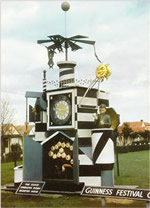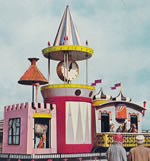The Guinness Festival Clock

It was the brainchild of the Guinness Advertising Manager Martin Pick, who had trained as an engineer before he entered the world of advertising. The Clock was designed by the firm of Lewitt Him and took five months for clockmakers Baume and Co Ltd. of Hatton Garden to construct. Standing 25 feet high, the Clock's internal mechanism was highly elaborate and included nine reversible electric motors and three synchronous clocks.
No clock of comparable complexity had been made in England for 300 years. Every fifteen minutes the crowds were spellbound by the four and a half minute routine featuring well known characters from Guinness advertisements which everybody knew at the time. The 'Guinness animals' were the creation of artist John Gilroy of S.H.Benson's advertising agency. He produced a series of colourful and amusing posters in which different zoo animals made off with their keeper's Guinness! (The zoo keeper was actually a caricature of Gilroy himself.)
The menagerie included a sealion (balancing a glass of Guinness on its nose), an ostrich (who had just swallowed a glass of Guinness whole), a pelican, bear, lion, tortoise, kangaroo, crocodile and even an upside-down kinkajou. The most famous of all, however, was the Guinness toucan who retained the public's affection from his debut in 1935 right up to his final retirement in 1982. Guinness also made use of characters from Lewis Carroll's book 'Alice in Wonderland' in its advertising in the 1930s-50s. We might think it unheard of now to use characters from a children's book to advertise beer, but at the time it was quite acceptable. This explains why the Mad Hatter, with his fishing rod, appears on the Guinness Festival Clock, along with the zoo keeper, toucans and other Guinness animals.
So what did the Clock actually do? Well, as the mechanism came into action a musical box, provided with an amplifier in the base of the cabinet, was started up and played appropriate music during the time the figures were in action.
Step 1 - The Zoo Keeper
First on the programme was the Zoo Keeper who was housed in a pulpit-like compartment on the right of the clock, normally closed by a canopy similar to a gaudily coloured umbrella.
As the umbrella opened the Zoo Keeper rose up ringing his handbell and moving his head from side to side. While this was going on the gilded Sun disc above the Keeper's head gyrated like a windmill.
Technical Data:
The umbrella was timed to open just before the Keeper started to rise by means of a motor which operated the hinged canopy through a leadscrew and linkage. Another motor driven leadscrew then operated the Keeper, while two other worm-geared motors operated, one to move the Keeper's arm as he swung his handbell, the other to move his head from side to side.
Step 2 - The 'Toucan Ballet'
The double doors in the lower middle part of the clock tower now begun to open slowly. As the doors opened, the Toucans were revealed, performing their ballet around the Guinness Time Tree.
Technical Data:
The doors were operated by a motor driving a leadscrew, the nut on which operated the upper and lower chains, driving sprockets which ran freely on vertical shafts at the two sides of the compartment. The upper sprocket on one side and the lower one on the other were provided with crank arms, which operated the door hinges through connecting links.
The mechanism for the Toucans incorporated a turntable operated by chain and sprockets from a worm-geared motor and the bird figures were supported by rods working freely in vertical guides. The rods had rollers at the lower end, resting on a cam track, so that the birds moved up and down, simulating a hopping motion as they moved round.
Step 3 - The Ostrich
On the left of the tower was a minaret with a spirally-striped chimney out of which the head of the Ostrich now emerged, complete with its characteristic dilation ('beer glassitis') of the neck.
Technical Data:
This was also operated by means of a motor-driven leadscrew; meanwhile, the chimney was gyrated by another worm-geared motor.
In order to enable the Ostrich's head to fit into the narrow chimney, the beak was made to fold upwards, a roller being fitted along the underside to prevent undue friction between the beak and the inside of the revolving chimney.
Step 4 - The Mad Hatter
Now the double doors of the minaret opened and the Mad Hatter stood on the threshold, leaning outwards with his fishing rod, trying to catch a fish from the well below.
Technical Data:
The Mad Hatter was operated by two toggle links from a leadscrew driven by another motor. The reeling of the line was operated by a worm-geared motor under the minaret roof, which drove a bobbin by a chain and sprocket; a belt from this also operated chains and sprockets inside the figure, working the arm and winding a dummy reel.
Step 5 - The Fish
The Mad Hatter had now caught his fish and a large specimen was drawn up from the well. From its open mouth emerged a slightly smaller fish and from that fish a smaller one until four fishes were seen suspended in mid air.
Technical Data:
This was contrived by operating a multiple line indirectly from a platform raised and lowered from the bobbin. Counterweights on the individual lines rested on the platform but had limited movement, controlled by stops, which determined the final height of each fish.
Step 6 - The Roundabout (or Whirligig)
The next part of the routine was the segmented roof of the clock that opened out like the petals of a flower. Hanging from each unfolded petal were characters from the Guinness adverts.
Technical Data:
The petals were operated by a linkage similar to that of an umbrella by a motor-driven leadscrew. Cords and pulleys attached to the sliding hub of the linkage then lowered the folded pendant figures into position. The whole assembly was rotated on its axis by a worm-geared motor through a chain and sprocket. The whole assembly rotated on its axis.
Step 7 - The Clock
Each component of the mechanism, having completed its 'turn', was retracted in reverse order, and finally the Zoo Keeper went down, ringing his handbell, the canopy closing over him as the music stopped.
Throughout the display the clock had, of course, been working. For such a complex clock, the time mechanism was small and simple, with a 'synthetic' tick which was amplified as necessary. Around the clock face was a transparent Zodiac ring but instead of the usual signs of the zodiac, it had coloured representations of the figures from the Guinness advertising posters. This ring rotated continuously.
Technical Data:
The clock mechanism consisted of a synchronous motor, with the necessary reduction gearing to the hands and switch contact dial. The Zodiac dial was rotated continuously by a friction roller from a small motor.
Version 2
The original Guinness Clock proved so popular that Guinness received enquiries from a number of local authorities, department stores and exhibition promoters who all wanted to borrow it for display. This inspired the building of slightly smaller 'travelling versions' of the clock, the first two of which were ready by September 1952. One went to Morecambe loaded on a Guinness trailer to be installed at Happy Mount Park as the main feature of the town's illuminations. It remained there until October 21st and was seen by thousands of people, young and old, as they walked through the park. Next it appeared in the fifth floor exhibition hall of John Lewis store in Manchester where, although it had to be dismantled to negotiate the stairs and the centre well, it was back in working order within three days. The other clock went to Southend's Western Esplanade as part of the seaside town corporation's illuminations. In all weathers and at all times people gathered to see the clock go through its routine. From Southend it went to Park Royal, where it stayed for a short time before moving on to Berwick-on-Tweed, where it stood in front of the town hall for the Christmas festivities. In all eight travelling Guinness Clocks and one miniature (5ft high) version were constructed, and they were seen at many places including Paignton, Barry Island, Folkestone, South Shields, Leamington Spa, the Isle of Sheppey, Chester, Warrington, Brighton, New Brighton, Southsea, Bristol, Great Yarmouth and Butlin's Holiday Camp, Ayr, Scotland (illustrated).
The clocks toured seaside towns for seven years or more and also made appearances at trade fairs, carnivals, agricultural shows and in department stores. One went to the USA on loan for two years, and two went to Ireland.
 On June 9th 1959 another Guinness Clock appeared called the Guinness Time Piece (pictured left), which also became known as the Guinness Clock. This was an even more elaborate mechanical contraption, built in three sections, weighing four tons, and mounted on the back of a trailer for easy transportation. It was designed by John Lansdell and Willy Szoomanski and manufactured by F.B.Elcom Ltd.
On June 9th 1959 another Guinness Clock appeared called the Guinness Time Piece (pictured left), which also became known as the Guinness Clock. This was an even more elaborate mechanical contraption, built in three sections, weighing four tons, and mounted on the back of a trailer for easy transportation. It was designed by John Lansdell and Willy Szoomanski and manufactured by F.B.Elcom Ltd.
As with the original Guinness Clocks, every quarter of an hour brought a frenzied burst of activity from an assortment of Guinness animals and their keeper accompanied by fairground music. In the centre a revolving stage with four set pieces showed Guinness in every season of the year and to the right in front of the caravan the ever-harassed keeper is chased by various animals from door to door. At first the keeper has the bottle of Guinness, then a few moments later, they all reappear, now running in the other direction, with the brown bear in front with the bottle being chased by the keeper. It was first exhibited at the Guinness Bicentenary Garden Party that summer then set off on its travels via Battersea Pleasure Gardens where it stayed for a fortnight. Since the Clocks' mechanism could easily be affected by wind, it was necessary to have an electrician standing by. He would also be responsible for counting the visitors to the clock.
Changing times were soon to doom these travelling mechanical wonders. Guinness no longer used the animals in its advertisements, and spare parts for the clocks became difficult to obtain. They were finally withdrawn in October 1966 and sent for scrap - a sad end to a much-loved and unique form of Guinness advertising.
Subscribed members can access our galleries and view 24 wonderful postcard images of the Festival Clock from various locations around the UK.